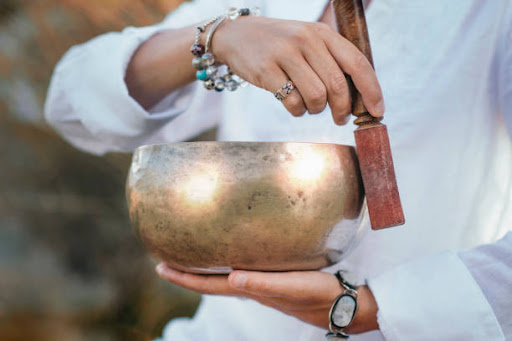What are those singing bowls that you see in Bhutan
The vibrations from the bowl affect your body and mind.

If you’re feeling stressed, need a timeout from life, or could simply use some rejuvenation… Try meditation!
Better still, meditate like the Bhutanese do, with a Tibetan singing bowl.
What is a singing bowl?
Think of a singing bowl as a bell. In fact, singing bowls are nicknamed “standing bells”, thanks to their bowl-like appearance. The bowls also go by other names, like resting bowl, prayer bowl, Himalayan bowl, Buddhist bowl, rin gong, etc.
The bowls are usually made of copper or tin, though some of the traditional ones come in a variety of metals, including mercury, lead, silver, iron, and gold.

When you strike the bowl or run a mallet around its rim/belly, the bowl emits a sound that some believe to possess healing properties. Others believe that this is the sound of “void”—the music of the universe.
The history of singing bowls
Different sources cite different origins of the singing bowls. One source says that the singing bowl can be traced back to the time when Padmasambhava spread Buddhism to Tibet from India in the 8th century BCE.
Another source suggests that the bowl originated from China around the 16th century BCE.
According to Tibetan culture, the singing bowls originated from the Bon Pot Shamans, sacred metallurgists who used their spiritual understanding of metals to make bowls that produce a unique sound and vibration. Sadly, there is no written record of the recipe of these metals.
Some ancient bowls are thought of as sacred relics. One particular bowl is believed to be the begging bowl used by an earlier incarnation of the Buddha. This treasured bowl currently sits in Drepung Monastery. The locals believe that the sound you get when using it is the sound of your karma!

How to use a singing bowl
Using a singing bowl might seem easy, but do not be fooled. It is actually an acquired skill that takes practice and patience to master.
First, lay the bowl on top of your opened left palm. If the bowl is small enough, cup your hand, and place the bowl on top of your fingertips.
To play the singing bowl, use either one of the following techniques:
- Strike the bowl with the mallet. This produces a sound similar to the ringing of a bell.
- Circle the rim/belly with the mallet. This creates a sustained, angelic tone. When you achieve the sound, remove the mallet and let the bowl ‘sing’. If you wish, you could strike the bowl before the circular motions.
- Fill the bowl with water. The liquid produces a unique sound when you play. After you achieve the sound, tilt and swirl the bowl, letting it continue its vibration.
As you play, relax your mind and focus on the bowl. Use your whole arm to create the motion and not just your wrist.
This kind of mediation differs from another kind of singing bowl meditation where someone else plays, and you do not perform any movement. Performing your own movement is great, because it can help you declutter your thoughts.

How you arrange the bowls is up to you, but there are preferred configurations. They could be placed around your body, on your body, or in different spots around the room.
The role of singing bowls
Singing bowls have a big role to play in sound therapy, consistent with the sound therapy beloved by indigenous people throughout the world that uses pulsing sounds, clapping, drumming, and singing—often for ceremonial, spiritual, and health purposes.
The configuration of the bowl placement is in relation to the person’s chakra. The harmonic vibrations of the bowl create balance and promote relaxation, activating the person’s chakras. Thus, the position, size, and usage of the bowls depend very much on the circumstances.

Furthermore, the singing bowls are also used to facilitate entry into a deep meditative state. When your brain synchronises with the sound frequencies of the bowl, you find it easier to focus and relax.
People all over the world—from east to west—wax lyrics about the singing bowl. Here are some theories why:
- The vibrations from the bowl affect the body and mind.
- The sound impacts brain waves, inducing relaxation.
- The sound might encourage the same psychological effects as music does.
If you think this is cool (and you could really use that much-talked-about relaxation), why not try out a singing bowl for yourself? You will not be disappointed.
Where can you find a singing bowl in Bhutan?
You can easily find singing bowls in souvenirs and handicraft shops along Thimphu and Paro. You are spoilt for choice as the singing bowls come in all shapes and sizes. Just pick one that you resonates with you.
Also, find out how a 70-year-old sound healer introduced gong therapy to Bhutan in the midst of COVID-19 pandemic.




